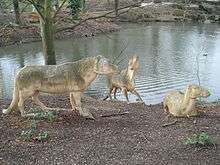Anoplotheriidae
Anoplotheriidae is an extinct family of even-toed ungulates (order Artiodactyla). They were endemic to Western Europe during the Eocene and Oligocene epochs about 48—23 million years ago (Mya), existing for about 25 million years. They disappeared at the end of the Oligocene, leaving no survivors today.[1] Its name is derived from the Ancient Greek: ἂνοπλος ("unarmed")[2] and θήριον ("beast"),[3] translating as "unarmed beast".
| Anoplotheriidae | |
|---|---|
 | |
| 19th-century reconstruction of Anoplotherium at Crystal Palace, London | |
| Scientific classification | |
| Kingdom: | Animalia |
| Phylum: | Chordata |
| Class: | Mammalia |
| Order: | Artiodactyla |
| Superfamily: | †Anoplotherioidea |
| Family: | †Anoplotheriidae Gray, 1821 |
| Subfamilies | |
|
Anoplotheriinae | |
| Synonyms | |
|
Anoplotheriina Bonaparte 1850 | |
They were most likely mid-sized terrestrial herbivores not too distantly related to camels, but smaller and low-slung with long and thick tails, and rather generalistic. The climate during their time was warmer than today, and their habitats were probably subtropical or even tropical, with plentiful rainfall and abundant vegetation. Tropical rainforest may at least initially have occurred all over the Anoplotheriidae's range. Ecologically, they may have resembled a large duiker of our time (e.g. the similarly sized yellow-backed duiker Cephalophus silvicultor), foraging in dense growth where their low builds would have been advantageous.
Systematics and taxonomy
The family Anoplotheriidae was assigned to Tesserachenae by Gray in 1821, to Belluae by Bonaparte (who named it Anoplotheriina) in 1850; to Artiodactyla by Cope in 1889, to Ruminantia by Gregory in 1910, and finally to its own superfamily Anoplotherioidea by Romer in 1966.[4][5][6]
Here, the Anoplotherioidea are also considered to include the Cainotheriidae and Dacrytheriidae. Other authors treat the former as more distantly related and sometimes include the Dacrytheriidae in the Anoplotheriidae as a third subfamily, Dacrytheriinae. On the other hand, the Robiaciinae can be considered the most basal branch of the Anoplotheriinae, resulting in no subfamilies at all being recognized, or be elevated to a fourth (or third) family in the Anoplotherioidea.
The subfamilies and genera included here are:
Subfamily Robiaciinae Sudre, 1977 (basal; disputed)
- Genus Robiacina Sudre, 1969
Subfamily Anoplotheriinae Gray, 1821 (advanced)
- Genus Anoplotherium
- Genus Deilotherium Filhol, 1882
- Genus Diplartiopus (tentatively placed here)
- Genus Diplobune Rutimeyer, 1862
- Genus Duerotherium
- Genus Ephelcomenus Hurzeler, 1938
- Genus Hyracodontherium (tentatively placed here)
- Genus Robiatherium Sudre, 1988
References
- PaleoBiology Database: Anoplotheriidae, basic info
- ἂνοπλος. Liddell, Henry George; Scott, Robert; A Greek–English Lexicon at the Perseus Project
- θηρίον. Liddell, Henry George; Scott, Robert; A Greek–English Lexicon at the Perseus Project
- C.-L. Bonaparte. 1850. Conspectus Systematis Mastozoologiae. Editio Altera Reformata [Survey of the system of mammals. Second revised edition].
- E. D. Cope. 1889. Synopsis of the families of Vertebrata. The American Naturalist 23:1-29
- J. J. Hooker. 1986. Mammals from the Bartonian (middle/late Eocene) of the Hampshire Basin, southern England. Bulletin of the British Museum (Natural History) 39(4):191-478